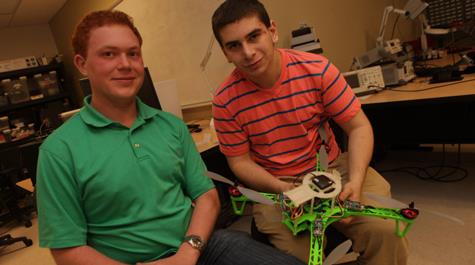Robotics Club project: Scratch-build a quadcopter, then teach it to fly
Flying a quadcopter is fun. Building your own quadcopter is even more fun. But the ultimate is building a robotic quadcopter — one that flies itself.
That’s the goal of the William & Mary Robotics Club. Since the club’s inception in 2014, members of the club have been coming up with interesting challenges in the field of robotics.
Club members Brandon Buncher ’17 and William Laney ’18 got together at the end of the academic year to discuss progress with Assistant Professor Wouter Deconinck of the physics department. Deconinck is the advisor for the robotics club. He explained that the club has a series of three overlapping challenges: build a quadcopter, get it to fly, and then program it to make it fly by itself.
“This is a project that’s challenging, but it’s feasible,” Buncher said. “And it’s fun to program.”
A quadcopter has four arms. Each arm has a rotor at the end to lift the craft off the ground. Laney explained that in order for the device to fly, it needs to have accelerometers, propellers and a communication system to connect it to a controller.
The robotics club constructed their quadcopter using 3-D printers and other equipment in two of the makerspaces on campus. It was a scratch build. The club designed and printed out part of the frame in the Small Hall Makerspace. Other parts were printed in the Miller Hall Makerspace by James Bradley, a professor in the Mason School of Business. The only parts off the shelf were the propellers and some electronic components. A lot of brainstorming went into the design.
“Thinking like a physicist has helped a lot. We are used to collaborating on problem sets, so it really helped working in a group setting for problem solving,” Buncher said.
To make their design as lightweight as possible, the team is opting for lithium polymer batteries or lithium ion batteries. According to Deconinck, in order for the quadcopter to keep itself in the air and stable, it has to generate enough lift, which means the propulsion system must be a balance between weight and power. Stability in the air is another issue.
“If one motor worked more than the others, the whole thing would tip. You need some kind of autopilot for stability control,” Deconinck said. “If you don’t have that, it’s not going to hang still in the air.”
Buncher and Laney, both physics majors, believe some of the most exciting parts of the challenge are the design elements as well as the coding.
“There’s sort of an overlap from physics because you are learning how the robot works,” Laney said. “You need it to function in a physical space so you need to understand a variety of disciplines.”
Now that the quadcopter itself has been built, the next set of tasks centers on getting the craft to fly reliably using a remote control device. Then, the club members will turn to a whole different series of problems related to autonomous flight— programming the ability to self-correct for stability, height and speed. Autonomous operation is achieved by coding a series of microcontrollers, thin electronic boards about two square inches. The microcontrollers collect data and output it for interpretation.
Each board has pins assigned to different variables. The information stored on the pin can then be transmitted throughout the entire system. Deconinck explained that these microcontrollers are connected to wi-fi. They also can run programs to perform other functions such as collecting, logging and reporting topography data.
Buncher explained that having the ability to process data relevant to velocity, speed, acceleration, height and other variables on board would allow the robot to make real time decisions in the air.
“That’s where these electronic boards come in,” Deconinck said. “You can have a GPS chip, an altitude controller and a third that controls the motors. If it starts to tilt this will generate that information and allow the quadcopter to correct it.”
Once the quadcopter is fully autonomous and flying well, it can be used for a number of purposes. Laney says they’ll start with attaching camera to take pictures and videos from above, but there are many other possibilities that can be integrated into this design. Deconinck noted that infrared cameras to detect heat and lasers to measure height and topography could be added to the quadcopter eventually to give it broader functionality.
“What they have to figure out is how to construct the robot, source the right components, motors, electronic boards and cables and hook it all up correctly,” Deconinck said. “Developing that is the robotics challenge.”














